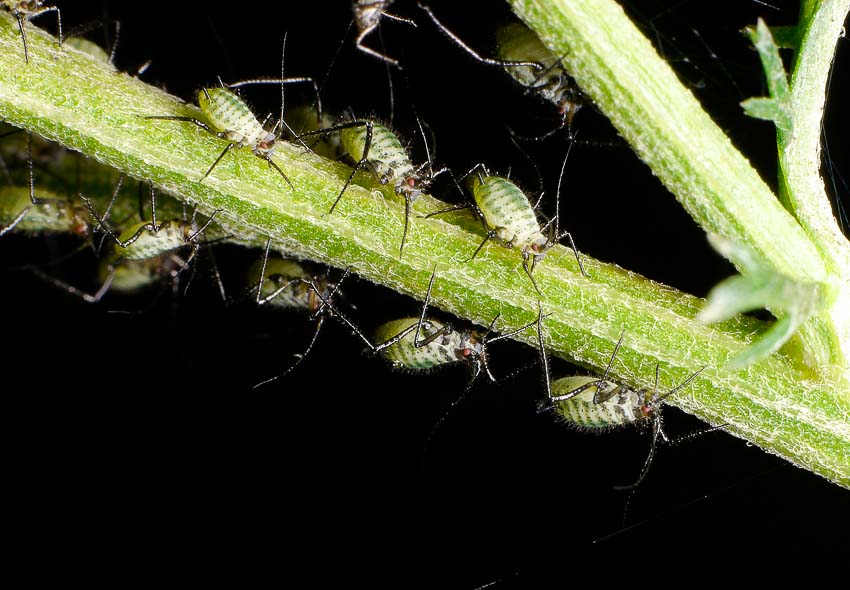The first sign of an aphid problem in your garden is shriveled and curling leaves. Aphids can cause damage to young seedlings and tender new shoots, especially in the spring when there is lush plant growth. Discover everything you need to know about aphids, including how to identify and control them.
What Are Aphids?
Aphids are tiny bugs that suck the juices and nutrients from young plants and delicate stems of perennials, shrubs, and trees. Aphids get their colloquial name–ant cows–because ants will often herd them for the sweet honeydew that they excrete.
Other names include plant lice, garden lice, green flies, and wooly aphids.
The Biology of Aphids
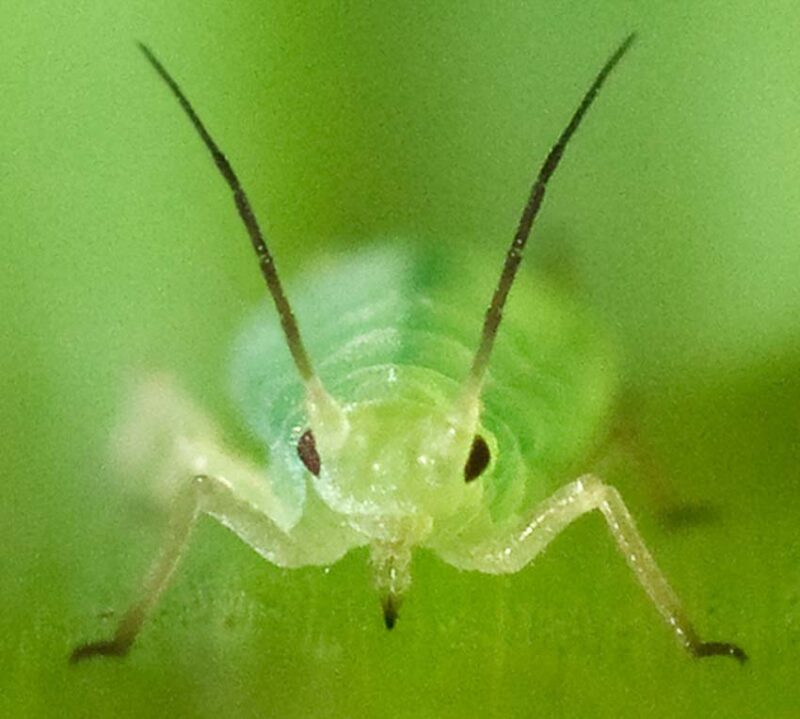
The Aphid Family, Aphidoidea, consists of over 4,000 subspecies. Of those, about 250 are considered to be pests.
They have pear-shaped bodies and occur with or without wings. Aphids range in size and color. Depending on the species, they are less than ⅛ inch long and can be brown, black, green, reddish-pink, white, or yellow.
Aphids primarily occur in northern temperate climates, and you will usually see them in spring when temperatures increase to 65° to 80°F (18° to 27°C).
Aphids reproduce sexually and asexually. And since each female can produce 50 to 100 offspring per generation, with over 30 generations per season, they reproduce rapidly under the right conditions.
Because they are soft-bodied insects, aphids die off naturally once temperatures reach 90°F (32°C). Serious infestations of aphids can be a nuisance for gardeners, as they can damage or destroy valuable crops. Moreover, the sticky substance they secrete can cover other plants, creating a habitat for sooty mold.
Aphids and Their Life Cycle
Aphids have unique, complex lifecycles, allowing them to adapt to different host species and reproduce as quickly as possible throughout the growing season.
Holocyclic aphids
Different species of aphids have various types of reproduction and lifecycles. Some of them have holocyclic reproductive life cycles, which means they use both sexual and asexual reproduction.
In asexual reproduction in aphids, parthenogenesis occurs, which is where a female aphid produces another female aphid asexually, similar to cloning, without an egg. If you don’t control them, these female aphids continue to reproduce asexually until the end of summer.
The female aphids that are the offspring of this asexual reproduction are called stem mothers. As nymphs, they undergo three moltings to increase in size, but they remain exactly identical to their mother.
Anholocyclic aphids
Some species of aphids do not undergo sexual reproduction at all. Their lifecycles are based solely on parthenogenetic reproduction. The lifecycles of these types of aphids are considered to be anholocyclic.
Sexual reproduction
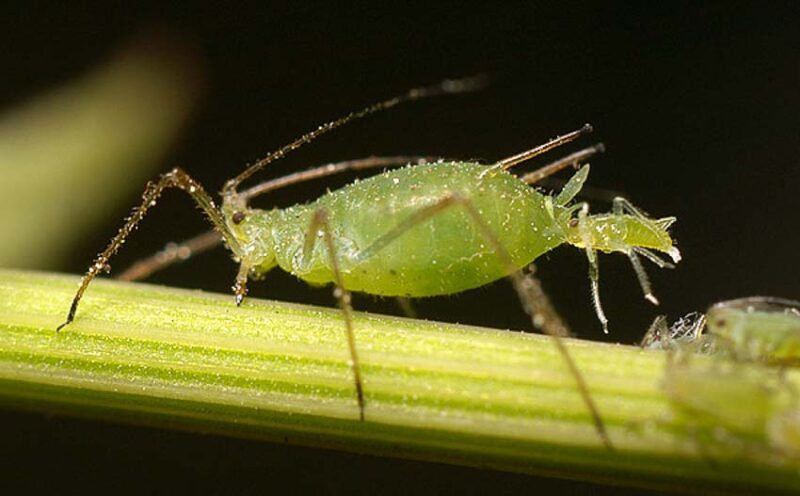
Asexual reproduction is the primary means of reproduction in most aphid species throughout the growing season, but in the fall, sexual reproduction occurs in some species. In sexual reproduction, the aphids’ life cycle consists of the egg, nymph, and adult stages.
Metamorphosis in aphids
Metamorphosis is a change process that many species, such as fish, amphibians, and insects, undergo to increase size and reduce competition between adults and offspring. Aphids use gradual or incomplete metamorphosis, with three distinct lifecycle stages.
Eggs–The eggs that hatch in the spring are almost exclusively female.
Nymphs–In this stage, nymphs look like small aphids, and they molt several times to increase in size before becoming adult aphids, a process that takes less than a week in warm weather.
Adults–In the adult stage, aphids lay eggs. Male and female aphids mate in the fall and the female lays eggs. These eggs can survive through the winter in harsh climates.
As you can see, the lifecycle of aphids can be confusing and complex, and it sometimes involves the migration of colonies to a new host plant to complete the cycle. The aphid life cycle can also include a caste system with soldier aphids, like that found in other complex societies of insects like bees, ants, and termites.
How to Identify Aphids
Aphids usually appear in large groups or colonies, although you can sometimes find them alone. Because they can be different colors and occur in both winged and wingless forms, you have to know what to look for in order to identify aphids.
Aphids’ Physical Characteristics
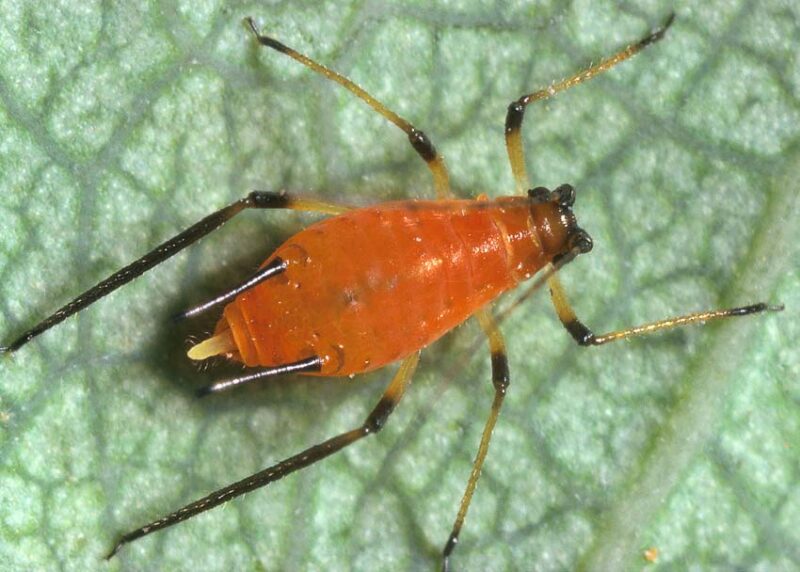
At less than ⅛ inch long, individual aphids are small. They are soft-bodied insects with long antennae and pear-shaped bodies.
Some have wings, and some do not, but their most distinguishing characteristic is the cornicles that protrude from the back of their body.
All aphids have a pair of cornicles that project outward from the 5th or 6th segment of their body. These cornicles are tubes that emit defensive secretions and pheromones. They are separate from the anus, where the honeydew nectar is excreted.
Some types of aphids appear waxy. The wax filaments protect them from predators.
Other species of aphids are fluffy due to the long waxy filaments that make colonies look like cotton or wool. Though many aphids are green, they can be a variety of colors, from black to white.
Since aphids rarely appear as individuals and are usually recognized in large groups, some scientists have referred to them as superorganisms. Clonal reproduction is more evidence that supports this theory, and indeed, the fates of aphids are collective.
Signs of Aphids in Your Garden
Often the easiest way to tell if your plants have aphids is by the damage they cause.
A colony of aphids can destroy tender leaves and stems by sucking the juice and sap out of them. If you notice this but don’t see any sign of aphids, look underneath the leaves, where they often feed.
A large infestation of aphids on a plant will cause the leaves to shrivel and become discolored. The growth of new leaves will be stunted, and all or parts of the plant may die.
You may also notice that leaves and stems are glossy, sticky, or waxy from the honeydew secretions. The honeydew attracts fungal infections and molds.
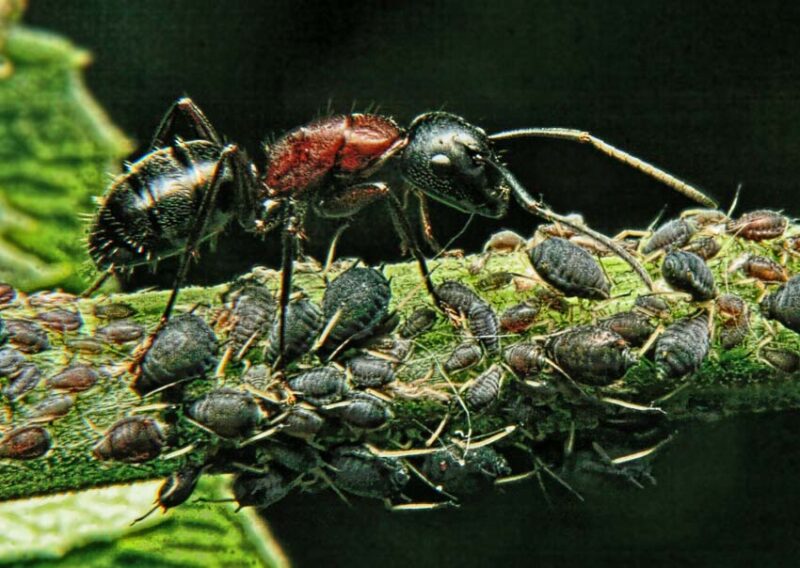
Aphids are often accompanied by ants, with whom they have a symbiotic relationship. Interestingly, ants farm or herd aphids on plants, and recent scientific studies have confirmed that both species benefit from the relationship.
Common Types of Aphids to Watch Out For
Worldwide, there are several thousand species of aphids, and in the United States alone, there have been 1,350 species cataloged. Of those, approximately 250 aphid species are recognized as pests.
Here are the most common types of aphids to watch out for:
- Myzus persicae–commonly known as the green peach aphid or greenfly
- Macrosiphum euphorbiae–usually known as the potato aphid, it’s typically a small and green aphid but can also be pink
- Macrosiphum rosae–the rose aphid’s main host is rosebushes in the spring, hiding on the underside of rose leaves
- Brevicoryne brassicae–the cabbage aphid is a gray-green color and usually feeds on cabbage, broccoli, and other brassicas
- Aphis fabae–a black aphid, also known as blackfly and black beet aphid, is a common pest of celery crops
- Eriosoma lanigerum–the wooly apple aphid lives on the roots and limbs of apple trees and can cause significant damage
Fortunately, you don’t need to be an expert at identifying aphids to control them, and there are several strategies you can use to prevent and get rid of them.
Got bigger pests to get rid of? Read our guides to groundhogs and raccoons!
Aphid Infestation: Why Should You Be Concerned?
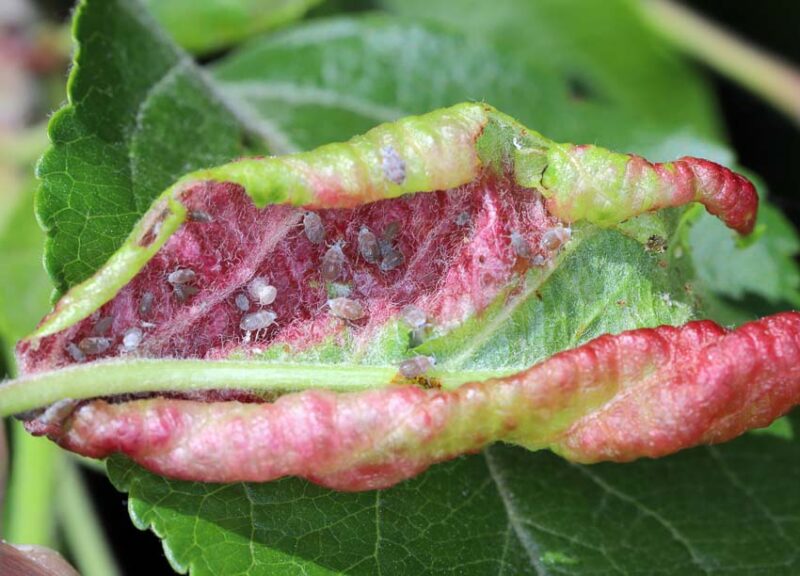
Aphid infestations can devastate plants, gardens, and crops, but they typically leave healthy plants alone. You’re more likely to see aphids on plants already weakened by unfavorable conditions, such as overcrowding, poor soil, over-fertilization, and drought.
The Harm Aphids Cause to Plants
Colonies of aphids can multiply quickly due to their asexual reproduction habits, leading to significant damage to crops. Aphids damage crops in more than one way, however.
Besides sucking the life out of plants, aphids can cause the following damage to crops:
- Stunted plant growth and reduced crop yields
- Virus transmission
- Provide favorable conditions for mold and fungi
- Contaminate produce with honeydew secretions and insect bodies
The Role of Aphids in Disease Transmission
Insect activity spreads most viruses that affect plants. Aphid control is so important because they are one of the most effective virus vectors. They can transmit virus particles for well over a week after being infected, with the winged generation causing the most damage.
More than 30% of the plant viruses spread by insects result from aphid activity.
Aphid Control: Proven Methods
Once you determine that you have an aphid problem, it’s important to take immediate action to eliminate them and prevent their spread. You can choose between several proven methods, including organic methods, chemical treatments, and biological controls.
Organic Methods to Control Aphids
You don’t need to use harsh chemicals to control aphids. Here are five natural methods for getting rid of aphids:
- Spray off with water. Use a steady stream of water to rinse them off your plants.
- Remove by hand. You can knock or rub off most aphids if you’re not too squeamish.
- Use homemade essential oil sprays. They are easy to make by mixing water with peppermint, clove, rosemary, or thyme oil in a spray bottle. Shake well before spraying.
- Use neem oil. This oil contains organic compounds that are effective against aphids and mealy bugs. You can purchase a ready-to-use neem oil spray or mix it yourself by diluting it in water.
- Make homemade insecticidal soap. Use 1 tablespoon of Castille soap to 1 quart of water, and spray on your plants.
Planting decoy plants like radishes and nasturtiums is another way to control aphids. You can also plant marigolds and herbs like basil and lavender to repel them.
Chemical Treatments for Aphid Infestation
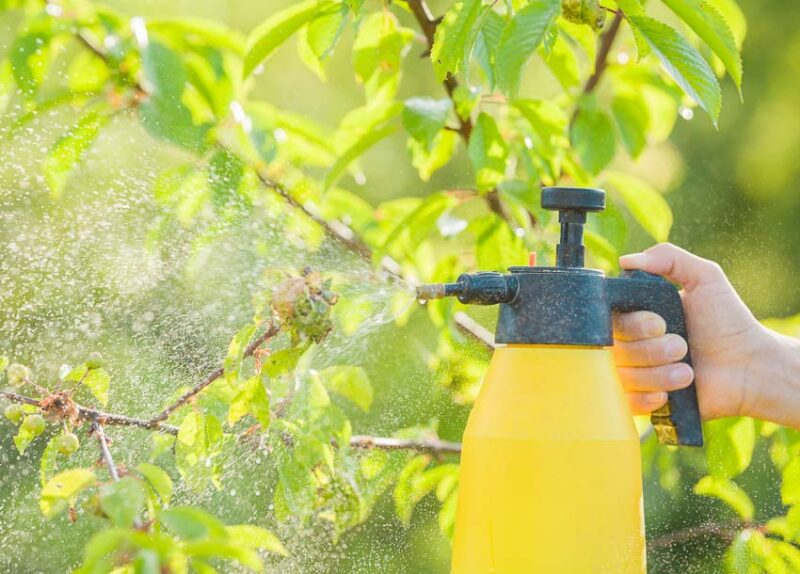
For serious infestations or when you’re growing a market crop, chemical treatments for aphids can help you prevent disaster. Here are a few top chemical products that will address your aphid problem.
- Safer 5118-6 Insect Killing Soap Concentrate –the active ingredient is potassium salts with fatty acids
- Southern Ag 10401 Natural Pyrethrin Concentrate –the active ingredient is natural pyrethrin compounds made from chrysanthemums
- Azamax –the active ingredient is Azadirachtin, which is an insect growth disruptor
- Monterey Garden Insect Spray –the active ingredient is imidacloprid, which is a systemic insecticide that kills aphids and other bugs
Beneficial Insects That Can Help Control Aphids
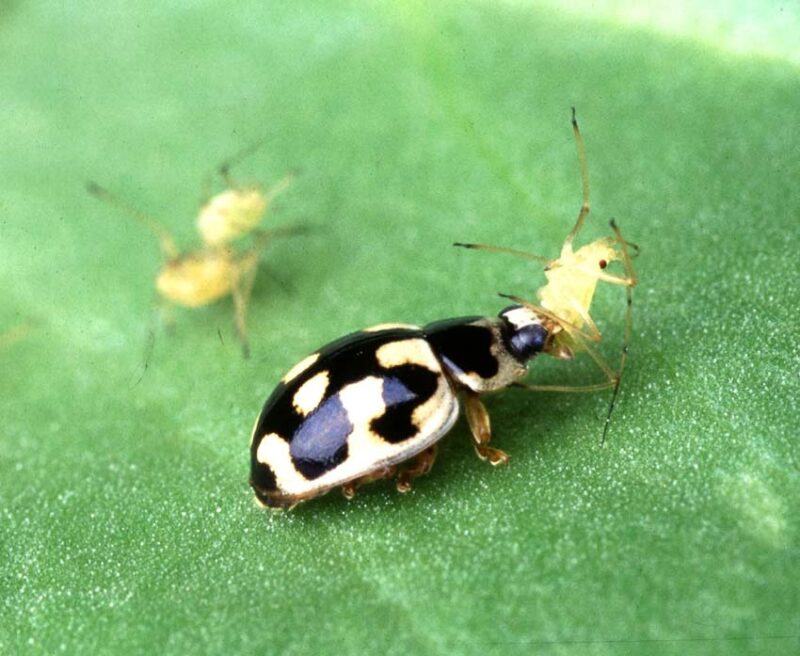
One of the easiest ways to control aphids is the most organic method.
Beneficial insects like ladybugs, lacewings, and parasitic wasps will help control aphid populations naturally. You can attract beneficial insects to your garden by providing a water source, like a small pond or shallow bowls of water.
Avoid the use of pesticides so that you don’t harm beneficial insects.
Learn how to get rid of mosquitos the natural way!
Aphid Control and Identification FAQs
What attracts aphids to my plants?
Aphids are attracted to plants that are stressed, but they prefer the tender shoots and leaves of new plant growth, which are high in nitrogen. Over-fertilizing your plants encourages succulent growth, which makes them more susceptible to aphids.
Can aphids harm humans or pets?
Aphids can’t harm pets or humans, but some aphids can bite. Aphid bites result in an itchy rash that disappears within a few days without treatment.
How quickly can aphids reproduce and spread?
Aphids are one of the fastest-spreading insects in the world, thanks to their unique reproductive systems. A single aphid can produce up to 100 offspring per week, with over 30 generations in a season.
Are certain plants more susceptible to aphids?
There are thousands of types of aphids, and many prefer specific host plants. Some plants most susceptible to aphids include squash, cucumbers, cabbage, roses, celery, potatoes, peaches, and apples.
How often should I check my plants for aphids?
Aphids in the garden are usually only a problem during the spring when succulent new growth attracts them or when plants are stressed. If you closely monitor your plants while they are young, you will notice signs of aphids, such as curling leaves.
Treat plants infected with aphids immediately to keep them from multiplying and spreading.
Of course, aphids aren’t the only threat to plants. Get the 411 on how to get rid of slugs!

